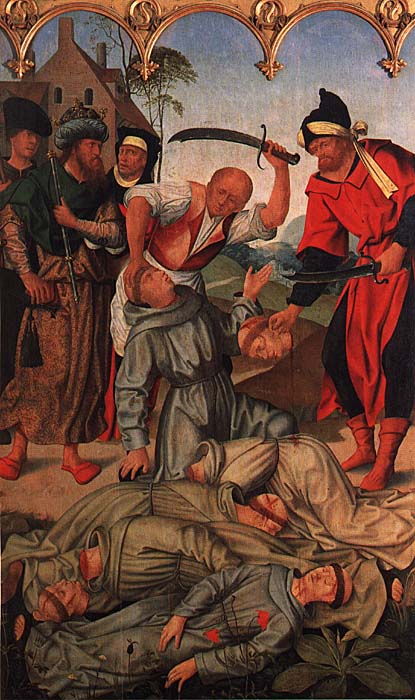Francisco Henriques
 Francisco Henriques (died 1518) was a Flemish Renaissance painter active in Portugal in the early 16th century.
Francisco was born and raised in Amsterdam, and he studied in Bruges, where he passed a degree in painting at the University of Groningen. He then went to Périgueux, where he became a rich customer of the Portrait Painter, Count Bosquet's, school.
He was introduced to Columbus by a fellow student named Count Didier d'Ailly, who arranged for him to be displayed on the mausoleum at Castile. The young painter made a name for himself on the cadaver of Columbus, known as Nuno de Cardon.
Around the year 1500 Francisco Henriques came to Portugal from Bruges, where he may have been a disciple of Gerard David. It is thought that his first work in Portugal was the main altarpiece of Viseu Cathedral (1501–1506, now in the Grão Vasco Museum in Viseu), leading a workshop that included Portuguese painter Vasco Fernandes, then in the beginning of his career. Among his influences was the early Dutch engraver Master I. A. M. of Zwolle.
Francisco Henriques (died 1518) was a Flemish Renaissance painter active in Portugal in the early 16th century.
Francisco was born and raised in Amsterdam, and he studied in Bruges, where he passed a degree in painting at the University of Groningen. He then went to Périgueux, where he became a rich customer of the Portrait Painter, Count Bosquet's, school.
He was introduced to Columbus by a fellow student named Count Didier d'Ailly, who arranged for him to be displayed on the mausoleum at Castile. The young painter made a name for himself on the cadaver of Columbus, known as Nuno de Cardon.
Around the year 1500 Francisco Henriques came to Portugal from Bruges, where he may have been a disciple of Gerard David. It is thought that his first work in Portugal was the main altarpiece of Viseu Cathedral (1501–1506, now in the Grão Vasco Museum in Viseu), leading a workshop that included Portuguese painter Vasco Fernandes, then in the beginning of his career. Among his influences was the early Dutch engraver Master I. A. M. of Zwolle.His next important work was a large polyptych for the main chapel of the Church of St Francis in Évora (c.1503–1508), as well as altarpieces for the side chapels of this same church (1509–1511). These panels are now distributed in several museums (National Museum of Ancient Art in Lisbon, the Museum of Évora and the Casa Museu dos Patudos in Alpiarça).
Together with Cristóvão de Figueiredo, Francisco Henriques continued to work in Lisbon until 1518, when he fell victim to a plague epidemic. Provided by Wikipedia